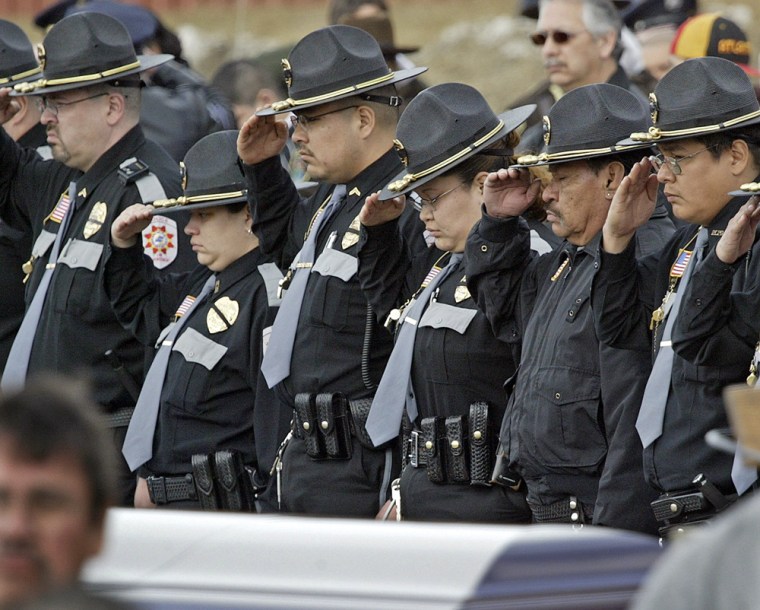With the bang of a drum and a high-pitched wail, the first funerals began Saturday for victims of the shootings on the Red Lake Indian Reservation in which 10 people died.
A lone man's sad cry gave way to songs and more drumming from a circle of a dozen men and soon hundreds of people who had gathered in the community center began filing past a pair of open caskets.
Daryl Lussier, 58, a tribal police officer, and his longtime companion Michelle Sigana, 31, were the first victims in Monday's attack by his grandson, Jeff Weise, 16.
More than 100 police officers attended the service for Lussier and Sigana, along with Gov. Tim Pawlenty and Sen. Norm Coleman. Every seat in the community center — bleachers, cafeteria tables, freestanding chairs — was taken.
After killing the pair in their home on the northern Minnesota reservation, Weise went to Red Lake High School, where he killed five students, a teacher and a security guard before shooting himself.
A third funeral, for 15-year-old Chase Lussier, was also planned Saturday at St. Mary's Catholic Church.
Searching for clues
While investigators say they don't know Weise's motive, a long trail of Internet postings paint a picture of a deeply depressed, suicidal boy. Friends and family members have said he had been taking the anti-depressant Prozac since a suicide scare last summer.
Family members told the New York Times that Weise's dose was recently increased to 60 milligrams a day.
"I can't help but think it was too much, that it must have set him off," an aunt, Tammy Lussier, told the paper.
Outside the Red Lake community center, which shares space with the Red Lake Band of Chippewa's Seven Clans Casino, an electronic sign flashed a message: "Red Lake Nation sends heartfelt condolences to all family members of tragic event. We are one in our sorrow and in our love."
On Saturday, President Bush made his first public comments on the shooting, praising a security guard credited with saving some students by confronting Weise. Bush said he and first lady Laura Bush were praying for the victims.
The Red Lake school isn't expected to reopen until next month.
It was the worst U.S. school shooting since the April 1999 rampage Columbine High School in Colorado, which ended in the deaths of 12 students, a teacher and two teen gunmen.
Traditional ceremonies
Three of the victims will have traditional tribal rites.
Thurlene Stillday, Chanelle Rosebear and Dewayne Lewis, all age 15, will be laid to rest in Ponemah, a deeply traditional community on the reservation where many families bury the dead in their yards.
“Ponemah has ... a long tradition of having their own Ojibwe faith and religion,” said Kevin Cease, director of the Bemidji funeral home handling the arrangements for all of the victims. “For them, that’s their roots.”
Ojibwes involved in the Ponemah services declined to describe details. Tribal elder Larry Stillday said the practices can only be appreciated by seeing them.
“The depth of it is way beyond a conversation with somebody,” he said.
Sending the deceased on a journey
Pipes, drums and rattles often are used to direct the departing soul and sing instructions, said Anton Treuer, assistant professor of Ojibwe languages at the American Indian Resource Center at Bemidji State University.
Sage is used to cleanse the thoughts of the survivors so their minds are not clouded by anger and sadness, Treuer said.
“It’s really comforting because you have a sense that this person is getting somewhere,” he said.
Instructions given to the departed are not supposed to be shared with the living, because doing so would be like sending a living person into the afterlife, Treuer said.
“This is something that has never been recorded on video or audiotape — even by the people who try to learn how to perform (the funerals),” Treuer said.
Though there is grief at these ceremonies, Treuer said it is different than the grief one might find at a Christian service.
“(Loved ones) let them go to where they have to go,” he said.
The ceremonies include a feast, which is shared with the departed. A spirit dish is sometimes placed in the casket. Families also sometimes include small items that will help the soul on the journey, such as a fire-starter kit or small spoon, Treuer said.
Also, Treuer said, rosy cheeks are painted on the face of the departed, showing that the soul will be happy when it meets its lost loved ones.
